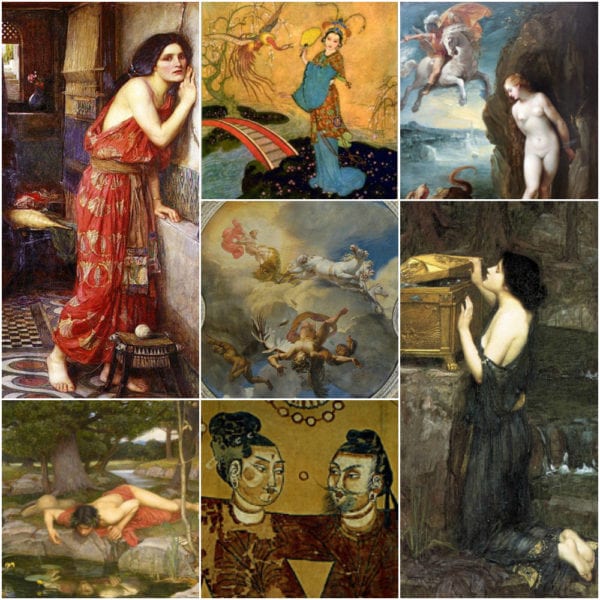From gods to nymphs to mere mortals: those whose stories have endured
From gods to nymphs to mere mortals: those whose stories have endured
From gods to nymphs to mere mortals: those whose stories have endured
-
Hannah
-
Hannah

Here are some of the mythical figures I have featured on my blog. There are so many more I could add; I am fascinated by the enduring stories that help us to make sense of the world and the characters of these legends that are, after all, so very like us.
Venice – setting of my novel The Echoes of Love – is known for many things in the cultural world: architecture, music, literature, the classic Commedia dell’arte. But for me, the most striking and beautiful of all the city’s gifts to culture is Murano glass, made exclusively on the islands of that name since the 13th century.
In this article, you can learn about the Murano glass love knot, a symbol of love whose origins can be found in the legendary love story of an Italian solider, Malco, and a water nymph, Sylvia.
When you boast that your daughter, Andromeda, is more beautiful than the nymph daughters of the sea god Nereus, it turns out that you annoy Poseidon, ruler of the sea. The result: Andromeda winds up naked and chained to a rock, waiting to be eaten by the sea monster Cetus. That is, until the hero Perseus comes to the rescue…
Prometheus was a rarity among the gods – a deity who really cared for humanity. But this Titan, who had moulded man from clay, angered the god Zeus by stealing fire for mortals. Zeus retaliated by having Prometheus chained to a rock and tortured by an eagle repeatedly tearing out his liver. His trial (which ended when he was saved by Hercules) inspired the Romantic poets Percy Bysshe Shelley and Lord Byron.
Prince Kamar and Princess Budur
This story, from the Arabain folk tales One Thousand and One Nights, is at the heart of my novel Legacy. When meddling genies bring Kamar and Budar together in their dreams, they fall in love – but then must find each other once awake. The twist in the legend is that whoever dresses in Kamar Al-Zaman’s or Princess Budur’s costume will meet the love of their life the first time they wear it. Where would one have need to wear such a costume? A masked ball of course, which features in Legacy.
My novel Aphrodite’s Tears, set in the Greek islands, draws on the mythology of the Ancient Greeks. The heroine, Oriel, is wary of the feelings she develops for the Greek island leader, Damian: She was flying too close to his heat, I write, like some foolish Icarus with wings of wax and feathers. There would only be herself to blame if she plummeted into the sea. Here, I am referring to the tale of Icarus from Ovid’s epic poem Metamorphoses, who tried to escape a tyrannous king wearing wings of his father’s creation, but drowned when he flew too close to the sun.
Autumn is upon us, the time of harvest. Persephone was the daughter of Demeter, goddess of harvest, and according to the myths, the reason we have winter is because Demeter mourns the loss of her daughter for four months each year, when Persephone must return to Hades in the Underworld. This article tells the story of how Persephone came to be Hades’ wife, and how the Ancient Greeks followed her cult.
Concerto is set on Lake Como, which is famous for its silk. The hero, Umberto, owns a silk-manufacturing factory, which makes silk from the mulberry trees on his estate – red and white. The legend of Pyramus and Thisbe, lovers from the city of Babylon, explains how the red mulberry came to be – steeped in their blood when they met a tragic end. It is surely from this story that Shakespeare took inspiration for Romeo and Juliet.
Here, I share how a trip to the Afqa waterfall in Lebanon some years ago brought me close to the legend of Aphrodite and her Adonis, lighting the spark for Aphrodite’s Tears. Poor Aphrodite lost her mortal lover, Adonis, and as she held his lifeless body in her arms, her tears mingled with his blood to make red flowers along the riverbanks that bloom still each year in remembrance of Adonis.
Theirs is a sad story of unrequited love. Echo, cursed by Zeus’s wife Hera to only utter the last words spoken to her, fell in love with Narcissus, but he cruelly rejected her and instead fell in love with his own reflection. He slowly wasted away as he admired himself in a pool of water, and the heartbroken Echo simply faded from existence, until all that remained was her voice.
In The Echoes of Love, the heroine, Venetia, befriends an old Chinese man who shares with her some of the ancient wisdom of his great land. Ping Lü gives Venetia a jade pendant of Nüwa and tells her: ‘This stone protects the wearer.’ The goddess Nüwa created mankind, and then saved it when heaven began to collapse.
‘You are a temptress,’ Damian tells Oriel in Aphrodite’s Tears. ‘Like the Sirens of our mythology, desirable, with a fatal beauty.’ I take a look at how the beautiful, but deadly Sirens were depicted in Ancient Greek mythology, and how we have since come to portray and define strong, independent women.
Poor Pandora. She was the first woman, and what a situation she found herself in: she was created to be the downfall of man. What was in her box? Why was she compelled to open it, and what happened when she did? In my article, I introduce you to this mortal who unwittingly unleashed evil into the world (yes, just like Eve in the Old Testament).